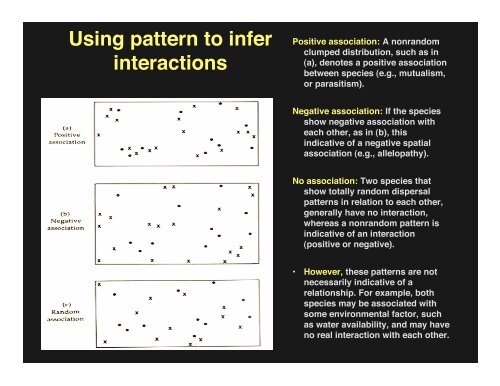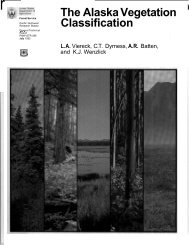Lectures on species interactions and competition
Lectures on species interactions and competition
Lectures on species interactions and competition
Create successful ePaper yourself
Turn your PDF publications into a flip-book with our unique Google optimized e-Paper software.
Using pattern to infer<br />
interacti<strong>on</strong>s<br />
Positive associati<strong>on</strong>: A n<strong>on</strong>r<strong>and</strong>om<br />
clumped distributi<strong>on</strong>, such as in<br />
(a), denotes a positive associati<strong>on</strong><br />
between <strong>species</strong> (e.g., mutualism,<br />
or parasitism).<br />
Negative associati<strong>on</strong>: If the <strong>species</strong><br />
show negative associati<strong>on</strong> with<br />
each other, as in (b), this<br />
indicative of a negative spatial<br />
associati<strong>on</strong> (e.g., allelopathy).<br />
No associati<strong>on</strong>: Two <strong>species</strong> that<br />
show totally r<strong>and</strong>om dispersal<br />
patterns in relati<strong>on</strong> to each other,<br />
generally have no interacti<strong>on</strong>,<br />
whereas a n<strong>on</strong>r<strong>and</strong>om pattern is<br />
indicative of an interacti<strong>on</strong><br />
(positive or negative).<br />
• However, these patterns are not<br />
necessarily indicative of a<br />
relati<strong>on</strong>ship. For example, both<br />
<strong>species</strong> may be associated with<br />
some envir<strong>on</strong>mental factor, such<br />
as water availability, <strong>and</strong> may have<br />
no real interacti<strong>on</strong> with each other.
















